Sistrum
A sistrum (plural: sistra or Latin sistra;[1] from the Greek σεῖστρον seistron of the same meaning; literally "that which is being shaken", from σείειν seiein, "to shake")[2][3][4] is a musical instrument of the percussion family, chiefly associated with ancient Egypt. It consists of a handle and a U-shaped metal frame, made of brass or bronze and between 30 and 76 cm in width. When shaken, the small rings or loops of thin metal on its movable crossbars produce a sound that can be from a soft clank to a loud jangling. Its name in the ancient Egyptian language was sekhem (sḫm) and sesheshet (sššt).
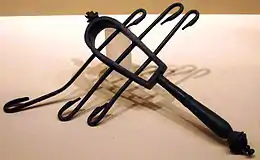
| Sistrum in hieroglyphs |
|---|
Sekhem is the simpler, hoop-like sistrum, while sesheshet (an onomatopoeic word) is the naos-shaped one. The modern day West African disc rattle instrument is also called a sistrum.[5]
The Egyptian sistrum
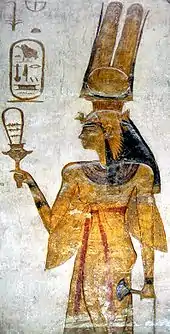
The sistrum was a sacred instrument in ancient Egypt. Perhaps originating in the worship of Bat, it was used in dances and religious ceremonies, particularly in the worship of the goddess Hathor, with the U-shape of the sistrum's handle and frame seen as resembling the face and horns of the cow goddess.[6] It also was shaken to avert the flooding of the Nile and to frighten away Set.[7]
Isis in her role as mother and creator was depicted holding a pail, symbolizing the flooding of the Nile, in one hand and a sistrum in the other.[8] The goddess Bast often is depicted holding a sistrum also, with it symbolizing her role as a goddess of dance, joy, and festivity.[9]
Sistra are still used in the Alexandrian Rite and Ethiopic Rite.[10] Besides the depiction in Egyptian art with dancing and expressions of joy, the sistrum was also mentioned in Egyptian literature.[11] The hieroglyph for the sistrum is shown.
The Minoan sistrum
The ancient Minoans also used the sistrum, and a number of examples made of local clay have been found on the island of Crete. Five of these are displayed at the Archaeological Museum of Agios Nikolaos. A sistrum is also depicted on the Harvester Vase, an artifact found at the site of Hagia Triada.
Researchers are not sure yet if the clay sistra were actual instruments that were used to provide music, or instead were models with only symbolic significance. But, experiments with a ceramic replica show that a satisfactory clacking sound is produced by such a design in clay, so a use in rituals is probably to be preferred.[12]
The sistrum today
The sistrum has remained a liturgical instrument in the Ethiopian Orthodox Church throughout the centuries and is played during the dance performed by the debtera (cantors) on important church festivals. It is also occasionally found in Neopagan worship & ritual.
The sistrum was occasionally revived in nineteenth century Western orchestral music, appearing most prominently in Act 1 of the opera Les Troyens (1856–1858) by the French composer Hector Berlioz. Nowadays, however, it is replaced by its close modern equivalent, the tambourine. The effect produced by the sistrum in music – when shaken in short, sharp, rhythmic pulses – is to arouse movement and activity. The rhythmical shaking of the sistrum, like the tambourine, is associated with religious or ecstatic events, whether shaken as a sacred rattle in the worship of Hathor of ancient Egypt, or, in the strident jangling of the tambourine in modern-day Evangelicalism, in Romani song and dance, on stage at a rock concert, or to heighten a large-scale orchestral tutti.
Classical composer Hans Werner Henze (1926-2012) calls for the flautist to play two sistra in his 1988 work Sonate für sechs Spieler (Sonata for six players).
West Africa
Various modern West African and Gabon rattle instruments are also called sistra (plural of sistrum): the calabash sistrum, the West Africa sistrum or disc rattle (n'goso m'bara) also called Wasamba or Wassahouba rattle. It typically consists of a V-shaped branch with some or many concave calabash discs attached, which can be decorated.[13]
Gallery
_-_TIMEA.jpg.webp) Broken Egyptian Sistrum
Broken Egyptian Sistrum Egyptian Sistrum
Egyptian Sistrum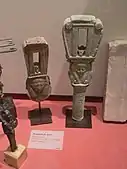 Collection of sistrums at the Louvre
Collection of sistrums at the Louvre.jpg.webp)
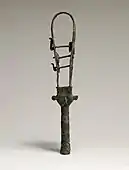 Walters Art Museum, ca. 380–250 BCE
Walters Art Museum, ca. 380–250 BCE Seated woman with sistrum on a coin issued under Hadrian
Seated woman with sistrum on a coin issued under Hadrian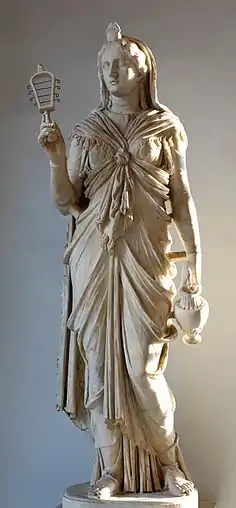 Romanized Isis holding a sistrum, also from the time of Hadrian
Romanized Isis holding a sistrum, also from the time of Hadrian School band player holding two disc rattles (sistra), Ziguinchor, Senegal, 1973
School band player holding two disc rattles (sistra), Ziguinchor, Senegal, 1973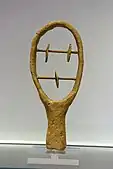
Footnotes
- Stein, Jess, ed. (1988). The Random House College Dictionary (Revised ed.). New York: Random House. p. 1230. ISBN 0-394-43500-1.
- sistrum. Charlton T. Lewis and Charles Short. A Latin Dictionary on Perseus Project.
- σεῖστρον, σείω. Liddell, Henry George; Scott, Robert; A Greek–English Lexicon at the Perseus Project.
- "sistrum". Oxford English Dictionary (2nd ed.). Oxford University Press. 1989.
- Smithsonian National Museum of African Art https://africa.si.edu/collections, search for sistrum
- Hart (2005), p. 65
- Plutarch (1936), cap. 63
- Merchant (1992), p. 115
- Hart (2005), p. 47
- Borroff (1971), p. 9
- The Instruction of Amenemope in Lichtheim (2006), p. 149
- Philip P. Betancourt, Costis Davaras, and Eleni Stravopodi, "Excavations in the Hagios Charlambos Cave: A Preliminary Report", Hesperia 77 (2008): 539–605.
- Musée virtuel Canada museevirtuel.ca/edu Calabash Sistra, Gabon
References
- Hart, George (2005). The Routledge Dictionary of Egyptian Gods and Goddesses (2nd ed.). Milton Park, UK: Routledge. ISBN 978-0-415-34495-1.
- Merchant, Carolyn (1992). Radical Ecology: The Search for a Livable World. Routledge. ISBN 978-0-415-90650-0.
- Plutarch (1936). Isis and Osiris. Loeb Classical Library. V.
- Borroff, Edith (1971). Music in Europe and the United States: A History. Prentice-Hall.
- Lichtheim, Miriam (2006) [1976]. The New Kingdom. Ancient Egyptian Literature. 2. Berkeley, CA: University of California Press. ISBN 978-0-520-24843-4.
External links
- Sistrum (Smith's Dictionary, 1875)
 Media related to Sistra at Wikimedia Commons
Media related to Sistra at Wikimedia Commons- . Encyclopædia Britannica (11th ed.). 1911.